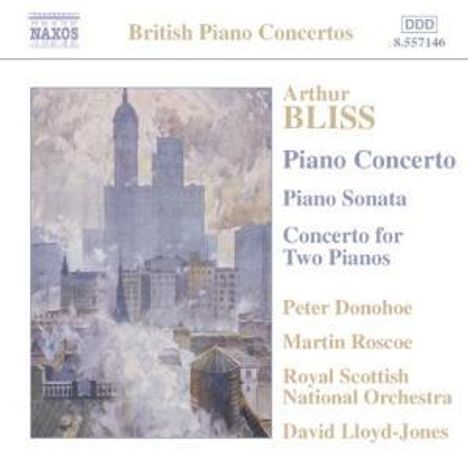Arthur Bliss: Klavierkonzert auf CD
Klavierkonzert
Herkömmliche CD, die mit allen CD-Playern und Computerlaufwerken, aber auch mit den meisten SACD- oder Multiplayern abspielbar ist.
Lassen Sie sich über unseren eCourier benachrichtigen, falls das Produkt bestellt werden kann.
+Konzert für 2 Klaviere; Klaviersonate
- Künstler:
- Peter Donohoe, Martin Roscoe, Royal Scottish National Orchestra, David Lloyd-Jones
- Label:
- Naxos
- Aufnahmejahr ca.:
- 2002/2003
- UPC/EAN:
- 0747313214624
- Erscheinungstermin:
- 12.1.2004
- Serie:
- Naxos British Piano Concertos
Ähnliche Artikel
Der British Council beauftragte Bliss, sein Klavierkonzert anlässlich der Britischen Woche auf der New Yorker Weltausstellung 1939 zu komponieren. Die Uraufführung fand am 10. Juni desselben Jahres statt, mit Solomon als Solist und dem New York Philharmonic Orchestra unter Adrian Boult.
Hier ist ein großartiges Werk, energisch, überschwänglich und unverblümt, aber in diesem ausgedehnten Rahmen gibt es auch Raum für ruhigere, persönlichere Emotionen, die in einer reichen lyrischen Ader dargestellt werden. Das Adjektiv "romantisch" ist ebenso angemessen für ein Werk, das in der Tradition der Konzerte von Liszt, Tschaikowsky und Busoni steht. In der Tat deuten die wilden Doppeloktaven zu Beginn des Werkes auf die Intentionen von Bliss hin, und es bedarf eines Virtuosen von hohem Rang, um sie zu erfüllen.
Das Konzert für zwei Klaviere hat seinen Ursprung in einem der experimentellen Werke, die die Singstimme ausnutzen, die Bliss in den Jahren unmittelbar nach dem Ersten Weltkrieg schrieb, dem Konzert für Klavier, Tenor und Streicher von 1921, das heute verloren ist. Bliss erkannte, dass diese ungewöhnliche Kombination ein Hindernis für weitere Aufführungen sein würde, entschied sich jedoch aufgrund seiner Vorliebe für das Werk, es als Konzert für zwei Klaviere mit einem Orchester aus Bläsern, Blechbläsern und Schlagzeug neu zu gestalten. In dieser Form wurde es 1924 in Boston uraufgeführt. Bliss war jedoch immer noch nicht zufrieden und orchestrierte es für volles Orchester neu, und als solches war es 1929 bei den Proms zum ersten Mal zu hören. Eine letzte Überarbeitung 1950 führte zu dem hier zu hörenden Werk, obwohl es noch eine weitere Metamorphose geben sollte, denn Bliss genehmigte 1968 eine Version für drei Hände für die Pianisten Phyllis Sellick und Cyril Smith.
Product Information
The British Council commissioned Bliss to compose his Piano Concerto to mark British Week at the 1939 New York World’s Fair. The première took place on 10th June that year, with Solomon as the soloist, and the New York Philharmonic Orchestra under Adrian Boult.
Here is a big-boned work, energetic, ebullient, and forthright, but within this expansive framework there is also room for quieter, more personal emotions portrayed in a rich vein of lyricism. The adjective ‘romantic’ is equally appropriate for a work following in the tradition of concertos by Liszt, Tchaikovksy and Busoni. Indeed the ferocious double octaves at the opening of the work indicate Bliss’s intentions and a virtuoso of a high order is required to fulfil them.
The Concerto for Two Pianos has its origins in one of the experimental works exploiting the voice that Bliss wrote in the years immediately after the first World War, the Concerto for piano, tenor and strings of 1921, which is now lost. Realising that this unusual combination would be a hindrance to further performances, yet being fond of the work, Bliss decided to recast it as a concerto for two pianos accompanied by an orchestra of wind, brass and percussion. In this form it received its première in Boston in 1924. Bliss was still not satisfied, however, and reorchestrated it for full orchestra, and as such it was first heard at the Proms in 1929. A final revision in 1950 resulted in the work heard here, although there was to be yet one more metamorphosis, for Bliss sanctioned a version for three hands in 1968 for the pianists Phyllis Sellick and Cyril Smith.
Disk 1 von 1 (CD)
-
1 Piano Concerto: Allegro con brio
-
2 Piano Concerto: Adagietto
-
3 Piano Concerto: Andante maestoso - Molto vivo
-
4 Piano Sonata: Moderato marcato
-
5 Piano Sonata: Adagio sereno
-
6 Piano Sonata: Allegro
-
7 Concerto for 2 Pianos and Orchestra: Allegro giusto - Larghetto tranquillo - Vivo









